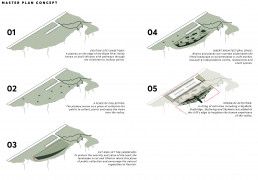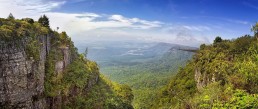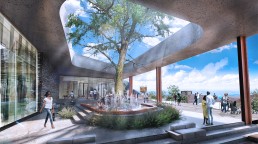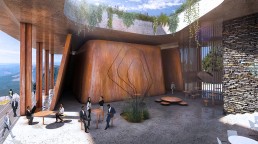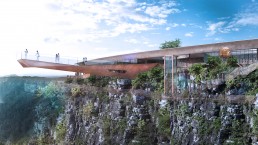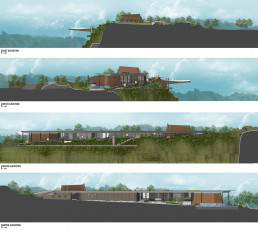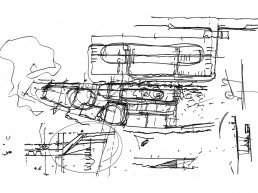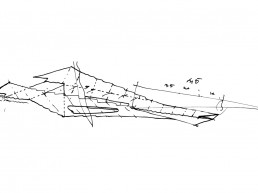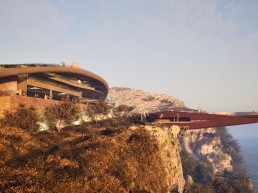A project fostering regional tourism for the Mpumalanga Tourism and Parks Agency located at 'God's Window', a popular panoramic viewing site which sits elevated on the Drakensberg escarpment within the Blyde River Canyon Nature Reserve.
The unique experience journeying through the site and taking in the views brings a sense of peace that has a subliminal undertone. Historical findings tell stories of a heritage of indigenous inhabitants that once lived with the land and found rest, meditation, and expression here and the surrounding Blyde River Canyon Reserve. These undertones are intended to be revealed and retained through three principles that strive to:
• protect the sanctity of the site by treating it in accordance
• protect the ecology through reducing the human impact by dispersing people
• create a heightened human experience
ARCHITECTURAL AND LANDSCAPE RESPONSE
The Architectural response to the sentiments of the three principles expresses the idea of ‘lifting the landscape’ and tucking the accommodation schedule underneath to give praise to the sacred nature of the land. The lifted landscape finds its expression as a green roof that is conceptualised as an ‘African oasis’ where people can meander through indigenous plants, curated landscapes that have mounds and terraces, curious rocks forms, steel structures and a variety of encounters with community and visitor.
The design of the site is based on seven lenses identified in workshops by the professional team as essential touchstones to make the project more desirable visible and feasible.
Circular Economy
Circular Economy is brought forward as a proposal that keeps revenue and production within the community. Where specialists will be needed to construct 'high risk' structures, job creation for building and maintenance is seen as a standard to be done by the local community, as far as is possible.
The craft market is envisioned to grow into a maker-space where crafts can be produced in-situ by locals and sold to visiting local and international tourists. This strategy encourages 'dwell time' within the market to enhance interaction and engagement.
Local community representatives will give tours as their knowledge of the fauna and flora along with local culture and history enriches the visitor experience while providing revenue streams for the community.
Community Inclusivity
The Communal Property Associations (CPAs) which include the Maorabjang, Moletele, Setlhare, and Mahubahuba community are custodians of the proposed development and form a part of the fabric of the daily happenings of various programs of the proposal. They will be the economic beneficiaries of the project and have been consulted with and included in the design process.
An outcome of this collaborative consultation can be seen in the Skywalk. The Praying Mantis insect informs its structural design concept and acknowledges the cultural significance of the site. The Mantis is a culturally a symbol of stillness and meditation and references the historical name for the area, Leboga Modimo (Give thanks to God) and the site's traditional use as a meditating and picnic area by individuals from the Maorabjang community.
Connection & Mobility
Intuitive connectivity to the landscape and panoramic views, along with the connection to local crafts and craftspeople, history, and information about the environment is managed through the architectural response to the site.
The 'lifting of the landscape' provides an elevated roof garden and leisure venue that honours the landscape. It is cut open at various placements to allow light into the spaces underneath that are arranged around five courts, namely the: 'Arrival Court', 'Market Court', 'Museum Court', 'Main Court', and 'Conference Court'.
These Courts form part of a journey that begins from the parking, out of a vehicle, in-between a wetland water filtration system, then into an inviting entrance that guides the visitor through a Ticket Office, Craft Market, Gift Shop and Museum & Interpretation Centre. The lower deck forms a part of a journey that leads into a promenade that represents a scaled-down experience of the pathways in the rainforest. The promenade hosts and introduces experiences that are both daring and curious, where clearings in the landscape encourage rest and reflection. The winding paths reveal SkyNests, a SkySwing, Zorbing, a SkyBridge, and a SkyWalk.
Storytelling as a design concept
Stories are tightly knitted into the fabric of the development. As much as the guided tours give a curated account of historical and present happenings and findings, stories are told through other means. The building in itself is a journey that weaves stories of Artisans at the Craft Market, Sculptures in the Museum Court, Photographs, Oral histories, and interactive displays in the Museum and Interpretation Centre. The local food tells stories of a heritage of food, and the performance space will host traditional dances and events. All of the featured areas tell the story of the unique location and cultural significance of the site.
Environment & Ecology Principles
Ecology and environment are seen as sacred, and the building and landscape emulate that through a blending of the building into the landscape. The strategy to lift the building off the land minimises the environmental impact of cutting into the natural rock of the escarpment edge, and the landscaping will celebrate endemic and indigenous plants.
A water filtration system leads into an attenuation pond at the lowest portion of the site, which is then pumped up to repeat the cycle reducing water usage. Materials used include sustainably farmed timber that references the site's indigenous rain forests while stone cladding the natural stone of the escarpment ridge. The stone will be sustainably sourced and constructed by local community craftsmen.
The ecology of the site is further protected through reducing the human impact by dispersing people through multiple journeys each affording various experiences.
Catering for ‘Future Tourists’
The idea of the Future Tourist encourages a development that caters for a technology-based experience that can enhance the natural experience that the site offers. A such a carefully curated range of spectacle and experiences are planned throughout the building to excite any, and all, social media moments. Scannable QR codes are placed throughout the building as information markers of historical, current, and future events and stories enabling the Future Tourist to guide themselves through the site and add to their individual visitor experience.
A Sustainable Business & Operational Model
Phase 1 of the development provides a destination landmark to attract local and international tourists while significantly boosting the local economy.
Ticket Offices, Craft market, Gift shop, Museum & Interpretation Centre, Restaurants, and service spaces host local staff and sell local cuisine and art such as craft, performance, tours, and special events.
Collaboration between the community and an established brand is envisaged as an opportunity to leverage mentorship engagements that result in higher quality craft products, with an increased monetary value increasing international exposure and sales.
The proposal is the Preferred Bidder, awaiting final tender adjudication.
| Client | Mpumalanga Tourism and Parks Agency |
| Developer | Thebe Group for MTPA (Mpumalanga Tourism and Parks Agency) |
| Area | 7 000 sqm |
| Quantity Surveyors | RLB Pentad |
| Engineering | Aurecon |
